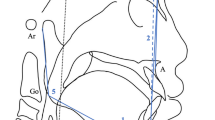Abstract
Introduction
Cephalometric analysis is an essential tool in the diagnostics and planning of orthognathic surgery. No objective criterion exists to facilitate decision making regarding genioplasties. Differing opinions amongst clinicians therefore leads to wide variability amongst treatment options offered to potentially suitable patients. This study has three aims. The first was to quantify the distribution of chin morphology amongst the average population using cephalometric analysis. Secondly, we sought to determine whether cephalometric parameters could be used to predict overlying soft tissue changes. Lastly, we consider the use of a new cephalometric angle, BNPg, for pre- and post-operative assessment of genioplasty patients.
Methods
This study retrospectively analysed 231 lateral cephalograms. The angle between the landmarks: B point, Nasion and Pogonion was measured to generate ‘BNPg’ a novel unit to quantify bony chin protrusion.
Results
The mean BNPg from all 231 samples was 1.12 degrees with a standard deviation of ± 1.35. Comparison between sexes showed no significant differences between male and females (P = 0.108). Furthermore, bony chin protrusion was found to strongly positively correlate with soft tissue chin appearance (r = 0.731), however, BNPg was found not to correlate with skeletal malocclusion (ANB, r = 0.085).
Conclusion
The novel unit BNPg may serve as a useful tool in contributing to the determination of treatment thresholds in osseous genioplasty for desirable aesthetic outcomes and may be used post-operatively to assess outcomes also. As this is a pilot study, further clinical studies would be required to validate this parameter in genioplasty patients, both pre- and post-operatively.



Similar content being viewed by others
References
Pampush JD, Daegling DJ (2016) The enduring puzzle of the human chin. Evol Anthropol 25:20–35
Gröning F, Liu J, Fagan MJ, O’Higgins P (2011) Why do humans have chins? Testing the mechanical significance of modern human symphyseal morphology with finite element analysis. Am J Phys Anthropol 144:593–606
Carrier DR, Morgan MH (2015) Protective buttressing of the hominin face. Biol Rev 90:330–346
Thayer ZM, Dobson SD (2010) Sexual dimorphism in chin shape: implications for adaptive hypotheses. Am J Phys Anthropol 143:417–425
Little AC, Jones BC, DeBruine LM (2011) Facial attractiveness: evolutionary based research. Philos Trans R Soc B Biol Sci 366:1638–1659
Hehman E, Flake JK, Freeman JB (2015) Static and dynamic facial cues differentially affect the consistency of social evaluations. Pers Soc Psychol Bull 41:1123–1134
Marshall SD et al (2011) Chin development as a result of differential jaw growth. Am J Orthod Dentofac Orthop 139:456–464
Chamberland S, Proffit WR, Chamberland P-E (2015) Functional genioplasty in growing patients. Angle Orthod 85:360–373
Hookey SR, Goodday RH (1989) New developments in genioplasty: functional versus cosmetic. Aust Orthod J 11:3–6
Hoenig JF (2007) Sliding osteotomy genioplasty for facial aesthetic balance: 10 years of experience. Aesthetic Plast Surg 31:384–391
Steiner CC (1953) Cephalometrics for you and me. Am J Orthod 39:729–755
Reddy PS, Kashyap B, Hallur N, Sikkerimath BC (2011) Advancement genioplasty––cephalometric analysis of osseous and soft tissue changes. J Maxillofac Oral Surg 10:288–295
Nanda SK (1992) Differential growth of the female face in the anteroposterior dimension. Angle Orthod 62:23–34
Signorelli L, Patcas R, Peltomäki T, Schätzle M (2016) Radiation dose of cone-beam computed tomography compared to conventional radiographs in orthodontics. J Orofac Orthop 77:9–15
Kumar BL et al (2015) Long term stability following genioplasty: a cephalometric study. J Int Oral Health 7:44–50
Frapier L et al (2010) Impact of genioplasty on mandibular growth during puberty. Int Orthod 8:342–359
Miloro M, Borba AM, Ribeiro-Junior O, Naclério-Homem MG, Jungner M (2014) Is there consistency in cephalometric landmark identification amongst oral and maxillofacial surgeons? Int J Oral Maxillofac Surg 43:445–453
Anon. East of England (United Kingdom). In: Counties and unitary districts & settlements—population statistics, charts and map. 2019. https://www.citypopulation.de/en/uk/eastofengland/. Accessed 21 Oct 2019.
Ferro A, Basyuni S, Brassett C, Santhanam V (2017) Study of anatomical variations of the zygomaticofacial foramen and calculation of reliable reference points for operation. Br J Oral Maxillofac Surg 55:1035–1041
Lundström A, Cooke MS (1991) Proportional analysis of the facial profile in natural head position in Caucasian and Chinese children. Br J Orthod 18:43–49
Bjork A (1963) Variations in the growth pattern of the human mandible: longitudinal radiographic study by the implant method. J Dent Res 42(1):400–411
Love RJ, Murray JM, Mamandras AH (1990) Facial growth in males 16 to 20 years of age. Am J Orthod Dentofacial Orthop 97:200–206
Foley TF, Mamandras AH (1992) Facial growth in females 14 to 20 years of age. Am J Orthod Dentofac Orthop 101:248–254
Funding
The authors report no commercial or financial associations that might pose or create conflict with information presented in the manuscript.
Author information
Authors and Affiliations
Corresponding authors
Ethics declarations
Conflict of interest
The authors of this study have no conflicts of interest.
Ethical Statement
Ethics approval not required for this study as per organisation protocol.
Additional information
Publisher's Note
Springer Nature remains neutral with regard to jurisdictional claims in published maps and institutional affiliations.
Supplementary Information
Below is the link to the electronic supplementary material.
Supplementary Fig. 1
qq-plots of measured parameters in male and female populations (PDF 293 kb)
Supplementary Fig. 2
Histograms and overlayed density plots for BNPg and BNPg* between males and females (TIFF 3768 kb)
Rights and permissions
Springer Nature or its licensor (e.g. a society or other partner) holds exclusive rights to this article under a publishing agreement with the author(s) or other rightsholder(s); author self-archiving of the accepted manuscript version of this article is solely governed by the terms of such publishing agreement and applicable law.
About this article
Cite this article
Chu, J., Basyuni, S., Moore, S. et al. A Novel Cephalometric Approach Aiming to Quantify a Normal Range of Bony Chin Protrusion. J. Maxillofac. Oral Surg. 22, 226–231 (2023). https://doi.org/10.1007/s12663-022-01784-5
Received:
Accepted:
Published:
Issue Date:
DOI: https://doi.org/10.1007/s12663-022-01784-5



